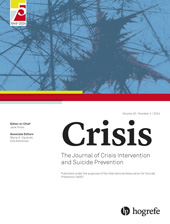Abstract
Abstract:Background: Previous studies have demonstrated that excluding individuals at risk of suicide from online depression interventions can impact recruited sample characteristics. Aim: To determine if a small change in suicide risk exclusion criterion led to differences in the usage and effectiveness of an Internet depression intervention at 6 months of follow-up. Method: A partial sample of a recently completed online depression intervention trial was divided into two groups: those with no risk of suicide versus those with some risk. The two groups were compared for baseline demographic and clinical measures, as well as intervention uptake and treatment success across 6 months. Results: Overall, individuals with less risk of suicide at baseline reported significantly less severe clinical symptoms. Both groups interacted with the intervention at the same rate, but specific use of modules was different. Finally, the impact of intervention usage on outcomes over time did not vary by group. Limitations: While different suicide risk exclusion criteria can change recruited sample characteristics, it remains unclear how these differences impact intervention uptake and success. Conclusion: Overall, the findings suggest that researchers should exercise caution when excluding individuals at risk of suicide, as they greatly benefit from web-based interventions.
References
(2020). Ethical issues and practical barriers in internet-based suicide prevention research: A review and investigator survey. BMC Medical Ethics, 21, Article
37 . 10.1186/s12910-020-00479-1(2021). Ethical concerns in suicide research: Thematic analysis of the views of human research ethics committees in Australia. BMC Medical Ethics, 22, Article
41 . 10.1186/s12910-021-00609-3(2010). e-hub: An online self-help mental health service in the community. The Medical Journal of Australia, 192(S11), S48–S52. 10.5694/j.1326-5377.2010.tb03694.x
(2004). Psychiatric diagnoses and suicide: Revisiting the evidence. Crisis, 25(4), 147–155. 10.1027/0227-5910.25.4.147
(2021). Prevalence of suicidal ideation and planning in patients with major depressive disorder: A meta-analysis of observation studies. Journal of Affective Disorders, 293(1), 148–158. 10.1016/j.jad.2021.05.115
(2014). Risks of all-cause and suicide mortality in mental disorders: A meta-review. World Psychiatry, 13(2), 153–160. 10.1002/wps.20128
(2018). Does providing a brief internet intervention for hazardous alcohol use to people seeking online help for depression reduce both alcohol use and depression symptoms among participants with these co-occurring disorders? Study protocol for a randomised controlled trial. BMC Open, 8, Article
e022412 . 10.1136/bmjopen-2018-022412(2014). Treatment dismantling pilot study to identify the active ingredients in personalized feedback interventions for hazardous alcohol use: Randomized controlled trial. Addiction Science and Clinical Practice, 10(1), Article
1 . 10.1186/s13722-014-0022-1(2005). Effectiveness of the derived Alcohol Use Disorders Identification Test (AUDIT-C) in screening for alcohol use disorders and risk drinking in the US general population. Alcohol: Clinical & Experimental Research, 29(5), 844–854. 10.1097/01.alc.0000164374.32229.a2
(2018). A closer look at substance use and suicide. Psychiatry, 13(6), 6–8. 10.1176/appi.ajp-rj.2018.130603
(2021). Falling between the cracks: The effect of using different levels of suicide risk exclusion criteria on sample characteristics when recruiting for an online intervention for depression. Suicide and Life Threatening Behavior, 54(4), 736–740. 10.1111/sltb.12761
(2021). Longitudinal studies support the safety and ethics of virtual reality suicide as a research method. Scientific Reports, 11, Article
9653 . 10.1038/s41598-021-89152-0(2001). The PHQ-9: Validity of a brief depression severity measure. Journal of General Internal Medicine, 16, 606–613. 10.1046/j.1525-1497.2001.016009606.x
(2019). Associations of suicide rates with socioeconomic status and social isolation: Findings from longitudinal register and census data. Frontiers in Psychiatry, 10, Article
898 . 10.3389/fpsyt.2019.00898(2011). Absolute risk of suicide after first hospital contact in mental disorder. Archives of General Psychiatry, 68(10), 1057–1064. 10.1001/archgenpsychiatry.2011.113
(2012). Effectiveness of a web-based cognitive-behavioral tool to improve mental well-being in the general population: Randomized controlled trial. Journal of Medical Internet Research, 15(1), Article
e2 . 10.2196/jmir.2240(2015). Examining undetermined and accidental deaths as source of ‘under-reported-suicide’ by age and sex in twenty Western countries. Community Mental Journal, 51, 365–376. 10.1007/s10597-014-9810-z
(1977). The CES-D scale: A self report depression scale for research in the general population. Applied Psychological Measurement, 1(3), 385–401. 10.1177/014662167700100306
(2015). Personal stigma in suicide attempters. Death Studies, 39(10), 592–599. 10.1080/07481187.2015.1037972
(2020). Suicide risk management in research on internet-based interventions for depression: A synthesis of the current state and recommendations for future research. Journal of Affective Disorders, 263, 676–683. 10.1016/j.jad.2019.11.045
(1993). Development of the Alcohol Use Disorders Identification test (AUDIT): WHO collaborative project on early detection of persons with harmful alcohol consumption–II. Addiction, 88(6), 791–804. 10.1111/j.1360-0443.1993.tb02093.x
(2017). The specificity of public stigma: A comparison of suicide and depression-related stigma. Psychiatry Research, 256, 40–45. 10.1016/j.psychres.2017.06.015
(2018). Implications of zero suicide for suicide prevention research. JAMA, 320(16), 1633–1634. 10.1001/jama.2018.13083
(2006). A brief measure for assessing generalized anxiety disorder: The GAD-7. Archives of Internal Medicine, 166(10), 1092–1097. 10.1001/archinte.166.10.1092
(2021). Core components and strategies for suicide and risk management protocols in mental health research: A scoping review. BMC Psychiatry, 21, Article
13 . 10.1186/s12888-020-03005-0(2018). Widening socioeconomic inequalities in Australian suicide, despite recent declines in suicide rates. Social Psychiatry and Psychiatric Epidemiology, 53, 969–976. 10.1007/s00127-018-1527-9
(2020). Conducting research with individuals at risk for suicide: Protocol for assessment and risk management. Suicide and Life Threatening Behavior, 50(2), 461–471. 10.1111/sltb.12602
(2005). Generalizability of antidepressant efficacy trials: Differences between depressed psychiatric outpatients who would or would not qualify for an efficacy trial. The American Journal of Psychiatry, 162(7), 1370–1372. 10.1176/appi.ajp.162.7.1370



